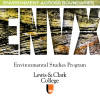Environmental Studies Blog
Plants Out of Place in North Portland
A few distinctive features of our ENVS 400 situated section, and update on work so far
Author

What if a team of ENVS students works in a shared situated context with community members toward their Senior Seminar capstone outcomes?
That is the experiment we are piloting this semester in one section of ENVS 400, focusing on north Portland, and specifically the Boise and Humboldt neighborhoods, part of the broad Albina District known historically for a rich multicultural and Black heritage. I’ll offer a background on our work here, and then students will check in when they get time with their own observations.
There are many potential advantages to this approach. Perhaps the key strength is that students build skills in community collaboration, devising environmental projects in response to felt community needs. This is just a one-semester undergraduate course, so we must be careful to choose projects that are doable, and potentially can be continued by students and the community in future.
What might be some possible senior projects in the Boise/Humboldt neighborhood? Well, in fall 2024 we asked members of the community!…and came up with quite a few possibilities. This document summarizes their initial priorities, then proposes three we considered with the community in late January, at a gathering hosted by First AME Zion congregation, the oldest Black church in the region. Along with the Boise Neighborhood Association, First AME Zion has been an active participant throughout the process, for which we are deeply grateful.

As an invasive species, the broad—we call them “framing” in our situated approach—questions one might ask of Tree of Heaven all point to its necessary eradication. But what if we approached Tree of Heaven in Boise/Humboldt neighborhood—what scholars think of as a hybrid object in a hybrid place—from multiple points of departure? That was our students’ initial challenge, for which I provided some broad framing question guidance in this document. Thus, Tree of Heaven in Boise/Humboldt neighborhood became a point of convergence for multiple big questions—biological, cultural, political, and others—they would explore in their capstone projects.

Once students get a breather from their common research, they may check in here with their individual and/or shared observations of Boise/Humboldt and their Plants Out of Place project.
Environmental Studies is located in room 104 of Albany Quadrangle on the Undergraduate Campus.
MSC: 62
email envs@lclark.edu
voice 503-768-7790
Symposium Advisor Jim Proctor
Environmental Studies
Lewis & Clark
615 S. Palatine Hill Road
Portland OR 97219
